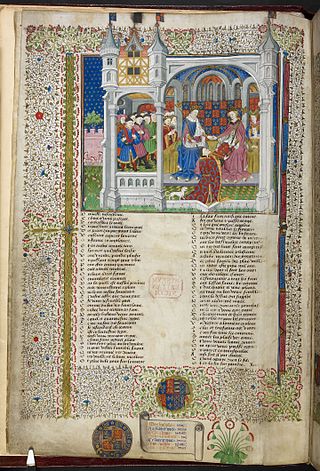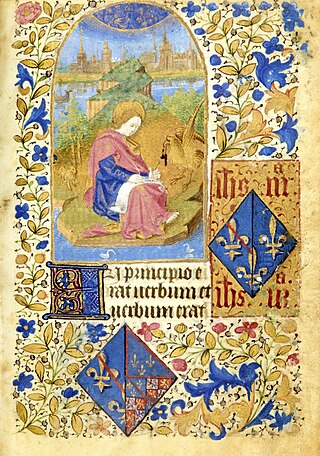History
The manuscript contains in its first historiated initial two characters, a knight and a lady kneeling in prayer before the Trinity and bearing the arms of two sponsors of the manuscript: Edward, Prince of Wales and future Edward I of England, and his wife, Eleanor of Castile. The work was carried out in successive stages between 1254, the date of their marriage, and 1272, when the prince acceded to the throne. [2] On stylistic and other grounds a more precise date of between 1265 and 1270 has been proposed. [3] The manuscript was made in Westminster, [4] or perhaps Canterbury. [5] No later owner is identified until the 19th century, when it was put up for sale at Christie's by William Wilson in 1833. It was acquired the same year by Francis Douce, who left his collection to the Bodleian Library at the University of Oxford on his death in 1834. [6]

Books of hours are Christian prayer books, which were used to pray the canonical hours. The use of a book of hours was especially popular in the Middle Ages, and as a result, they are the most common type of surviving medieval illuminated manuscript. Like every manuscript, each manuscript book of hours is unique in one way or another, but most contain a similar collection of texts, prayers and psalms, often with appropriate decorations, for Christian devotion. Illumination or decoration is minimal in many examples, often restricted to decorated capital letters at the start of psalms and other prayers, but books made for wealthy patrons may be extremely lavish, with full-page miniatures. These illustrations would combine picturesque scenes of country life with sacred images.

Illustrated Apocalypse manuscripts are manuscripts that contain the text of Revelation or a commentary on Revelation and also illustrations. Most of these Apocalypses were written between 1250 and 1400. The English Apocalypses are part of a larger group of Apocalypses called: the Anglo-Norman Apocalypses.

The Paris Psalter is a Byzantine illuminated manuscript, 38 x 26.5 cm in size, containing 449 folios and 14 full-page miniatures. The Paris Psalter is considered a key monument of the so-called Macedonian Renaissance, a 10th-century renewal of interest in classical art closely identified with the emperor Constantine VII Porphyrogenitus (909-959) and his immediate successors.

The Fécamp Bible is an illuminated Latin Bible. It was produced in Paris during the third quarter of the 13th century, and had previously belonged in the collection of Henry Yates Thompson.

William de Brailes was an English Early Gothic manuscript illuminator, presumably born in Brailes, Warwickshire. He signed two manuscripts, and apparently worked in Oxford, where he is documented from 1238 to 1252, owning property in Catte Street near the University Church of St Mary the Virgin, roughly on the site now occupied by the chapel of All Souls College, where various members of the book trade lived. He was married, to Celena, but evidently also held minor orders, as at least three self-portraits show him with a clerical tonsure. This was not unusual: by this date, and with the exception of the St Albans monk Matthew Paris, the only other English illuminator of the period about whom we have significant personal information, most English illumination seems to have been done in commercial workshops run by laymen.

Commentary on the Apocalypse is a book written in the eighth century by the Spanish monk and theologian Beatus of Liébana (730–785) and copied and illustrated in manuscript in works called "Beati" during the 10th and 11th centuries AD. It is a commentary on the New Testament Apocalypse of John or Book of Revelation. It also refers to any manuscript copy of this work, especially any of the 27 illuminated copies that have survived. It is often referred to simply as the Beatus. The historical significance of the Commentary is made even more pronounced since it included a world map, which offers a rare insight into the geographical understanding of the post-Roman world. Well-known copies include the Morgan, the Saint-Sever, the Gerona, the Osma and the Madrid Beatus codices.

Two lavishly illustrated illuminated manuscript psalters are known as the Psalter of Saint Louis as they belonged to the canonized King Louis IX of France. They are now in Paris and Leiden, and are respectively good examples of French Gothic and English Romanesque illumination.

The Talbot Shrewsbury Book is a very large richly-illuminated manuscript made in Rouen (Normandy) in 1444/5. It was presented by John Talbot, 1st Earl of Shrewsbury to the French princess, Margaret of Anjou, in honour of her betrothal to King Henry VI. It contains a unique collection of fifteen texts in French, including chansons de geste, chivalric romances, treatises on warfare and chivalry, and finally the Statutes of the Order of the Garter. The work is an excellent example of book production in Rouen in the mid-fifteenth century and provides a rare insight into the political views of the English military leader and close confidant of the crown, John Talbot.

The Manuscrit du Roi or Chansonnier du Roi is a prominent songbook compiled towards the middle of the thirteenth century, probably between 1255 and 1260 and a major testimony of European medieval music. It is currently French manuscript no.844 of the Bibliothèque nationale de France. It is known by various sigla, depending on which of its contents are the focus of study: it is troubadour manuscript W, trouvère manuscript M, and motet manuscript R. It was first published by French musicologist Pierre Aubry in 1907.

The Cloisters Apocalypse, MS 68.174 is a small French illuminated manuscript dated c. 1330. It is based on John the Evangelist's New Testament visions and apocalyptic revelation. According to Christian legend John was exiled c. 95 CE to the Aegean island of Patmos, where he wrote the Book of Revelation. The book evokes John's despair and isolation while exiled, and his prophecy of events and terrors of the last days.

The book of hours of Joan of France is a 15th-century illuminated manuscript forming a book of hours, named after Joan of France, Duchess of Bourbon, who owned the book in the 15th century. After her death, it passed to Catherine of Armagnac, whose coat of arms was added to the book. After her death, the whereabouts of the book are unknown; it reappeared again in the late 19th century when it was bought by private collector Victor Martin Le Roy. It then passed to his son-in-law, art historian Jean-Joseph Marquet de Vasselot. It was again sold in 2011, and then bought by the Bibliothèque nationale de France, thanks to funding from private donors. It is classified as a national treasure of France. The rich decoration, including 28 full-page miniatures, was mostly made by the so-called Master of Jouvenel.
This page is based on this
Wikipedia article Text is available under the
CC BY-SA 4.0 license; additional terms may apply.
Images, videos and audio are available under their respective licenses.











